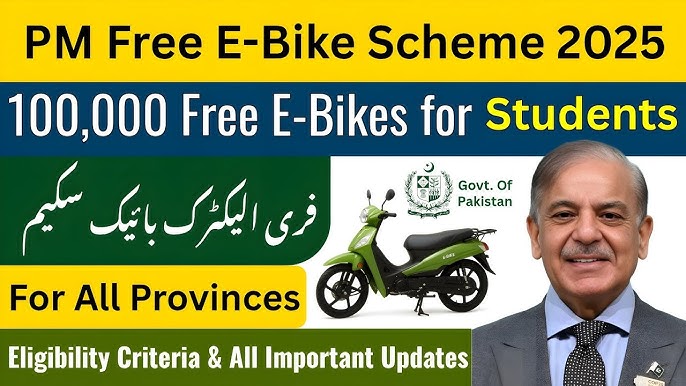In a bold step towards sustainability and student empowerment, the Prime Minister of Pakistan has recently announced a groundbreaking initiative—the distribution of free electric bikes to students across the country. This ambitious move not only seeks to reduce the cost of transportation for students but also promotes eco-friendly mobility in a time when climate change and fuel inflation are hot-button issues. Let’s explore the full details of this initiative, its features, benefits, drawbacks, and possible alternatives.
What Prime Minister Announces Free Electric Bikes for Students?
The announcement of free electric bikes for students was made by Prime Minister Shehbaz Sharif. Known for his active development policies and pro-youth initiatives, Shehbaz Sharif unveiled this plan as part of a broader effort to modernize student transportation and reduce carbon emissions. The idea is simple: empower students to reach their educational institutions with ease, comfort, and without burdening their families with daily fuel costs.
This initiative aligns with Pakistan’s national goals for digital transformation, youth facilitation, and a shift towards clean energy and reduced dependency on fossil fuels.
Prime Minister Announces Free Electric Bikes for Students
The “Free Electric Bike for Students” program is a government-backed plan where eligible students will receive electric bikes at no cost. Initially being piloted in Punjab, with future expansion to other provinces, the plan prioritizes students from low-income families, those enrolled in public universities, colleges, and technical institutions.

Key Points:
-
The bikes are 100% electric, meaning they run entirely on battery.
-
They are being distributed free of cost under the Prime Minister’s Youth Mobility Program.
-
The scheme also includes solar-powered charging stations to make the system sustainable.
-
It is designed to benefit both male and female students, promoting inclusivity and accessibility.
Features of Prime Minister Announces Free Electric Bikes for Students [Completely Detailing]
Here are the major features of the program:
| Feature | Details |
|---|---|
| Eligibility Criteria | Students enrolled in public institutions, with preference to financially weaker students |
| Type of Vehicle | 100% Electric Bikes (battery operated) |
| Range per Charge | Around 60-70 kilometers per full charge |
| Charging Time | 4–6 hours using standard charging or solar stations |
| Speed | Up to 45–60 km/h, depending on model |
| Cost to Students | Absolutely free (fully funded by the government) |
| Distribution Phase | Pilot in Punjab, expansion planned for Sindh, KP, Balochistan |
| Gender Inclusivity | Equal priority to female students with female-specific training programs |
| Safety Features | Comes with helmet, indicators, headlights, anti-theft lock |
| Environmentally Friendly | Zero emission, low noise pollution |
| Support System | Government is establishing maintenance and charging stations in campuses |
These features make this initiative not only generous but also highly impactful in day-to-day student life.
Pros of Prime Minister Announces Free Electric Bikes for Students [Use Table]
| Pros | Explanation |
|---|---|
| Cost Saving | Eliminates daily commute expenses for students and their families |
| Eco-Friendly | Zero emission contributes to better urban air quality |
| Time Efficiency | Helps students save time by avoiding delays in public transport |
| Educational Accessibility | Encourages regular attendance, especially for rural and female students |
| Empowerment | Promotes independence and confidence among youth |
| Digital & Green Vision | Aligns with Pakistan’s green energy and smart transport plans |
| Safety & Convenience | Bikes designed with student safety and simplicity in mind |
Cons of Prime Minister Announces Free Electric Bikes for Students [Use Table]
| Cons | Explanation |
|---|---|
| Limited Availability | Only a small number of bikes will be available in initial phases |
| Maintenance Costs | Although bikes are free, future maintenance might be a burden for some students |
| Charging Infrastructure | Charging stations are still limited in many areas |
| Security Risk | High risk of theft in certain regions if proper locks and storage are not provided |
| Traffic Inexperience | Younger students may lack experience to ride safely in city traffic |
| Battery Life Dependency | If battery health declines, performance and reliability may suffer |
While the benefits outweigh the drawbacks, these challenges highlight areas where the government must remain vigilant.
Prime Minister Announces Free Electric Bikes for Students Alternatives [Use Table]
If you are a student and this initiative isn’t yet available in your area, consider these alternatives:
| Alternative | Details |
|---|---|
| Student Discount Public Transport Cards | Available in many cities offering up to 50% off on bus/train fare |
| Bike Sharing Apps | In some areas, eco-friendly bike rentals (hourly-based) are available |
| Solar-Powered Scooters | Privately available through startups and NGOs at discounted rates |
| College Shuttle Services | Many universities provide free or subsidized shuttle services |
| Carpooling Groups | Students can use apps or university communities to share rides |
| Government Loans for EV Purchase | Easy installments or interest-free loans for electric vehicles |
These alternatives, while not as convenient as a free electric bike, still contribute to reducing commuting stress and expenses for students.
Prime Minister Announces Free Electric Bikes for Students
In conclusion, the Prime Minister’s announcement of free electric bikes for students is more than just a transport scheme—it’s a leap towards a smarter, greener, and student-friendly Pakistan. This initiative addresses multiple national concerns simultaneously: youth mobility, economic pressure, education access, and environmental sustainability.
For students, this could mean:
-
A newfound sense of freedom in commuting,
-
A relief from financial burden,
-
And a pride in being part of an eco-conscious generation.
However, its success depends on transparent distribution, proper follow-up, and infrastructure support. If implemented effectively, it has the potential to become one of the most impactful educational reforms in recent years.
